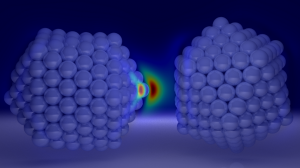Research paper entitled:
Atomistic Near-Field Nanoplasmonics: Reaching Atomic-Scale Resolution in Nanooptics
prepared in a collaboration between the groups of Daniel Sanchez-Portal (Material Physics Center CSIC-UPV/EHU, and Donostia International Physics Center (DIPC)), Andrey Borisov (Institut des Sciences Moléculaires d’Orsay ISMO, CNRS-Université Paris-Sud) and our group has been published in Nano Letters.
Abstract:
Electromagnetic field localization in nanoantennas is one of the leitmotivs that drives the development of plasmonics. The near-fields in these plasmonic nanoantennas are commonly addressed theoretically within classical frameworks that neglect atomic-scale features. This approach is often appropriate since the irregularities produced at the atomic scale are typically hidden in far-field optical spectroscopies. However, a variety of physical and chemical processes rely on the fine distribution of the local fields at this ultraconfined scale. We use time-dependent density functional theory and perform atomistic quantum mechanical calculations of the optical response of plasmonic nanoparticles, and their dimers, characterized by the presence of crystallographic planes, facets, vertices, and steps. Using sodium clusters as an example, we show that the atomistic details of the nanoparticles morphologies determine the presence of subnanometric near-field hot spots that are further enhanced by the action of the underlying nanometric plasmonic fields. This situation is analogue to a self-similar nanoantenna cascade effect, scaled down to atomic dimensions, and it provides new insights into the limits of field enhancement and confinement, with important implications in the optical resolution of field-enhanced spectroscopies and microscopies.
To read the whole paper, click here or go to the Nano Letters website.


